Ziyang Liu
Astra: Toward General-Purpose Mobile Robots via Hierarchical Multimodal Learning
Jun 06, 2025Abstract:Modern robot navigation systems encounter difficulties in diverse and complex indoor environments. Traditional approaches rely on multiple modules with small models or rule-based systems and thus lack adaptability to new environments. To address this, we developed Astra, a comprehensive dual-model architecture, Astra-Global and Astra-Local, for mobile robot navigation. Astra-Global, a multimodal LLM, processes vision and language inputs to perform self and goal localization using a hybrid topological-semantic graph as the global map, and outperforms traditional visual place recognition methods. Astra-Local, a multitask network, handles local path planning and odometry estimation. Its 4D spatial-temporal encoder, trained through self-supervised learning, generates robust 4D features for downstream tasks. The planning head utilizes flow matching and a novel masked ESDF loss to minimize collision risks for generating local trajectories, and the odometry head integrates multi-sensor inputs via a transformer encoder to predict the relative pose of the robot. Deployed on real in-house mobile robots, Astra achieves high end-to-end mission success rate across diverse indoor environments.
MCCD: Multi-Agent Collaboration-based Compositional Diffusion for Complex Text-to-Image Generation
May 05, 2025Abstract:Diffusion models have shown excellent performance in text-to-image generation. Nevertheless, existing methods often suffer from performance bottlenecks when handling complex prompts that involve multiple objects, characteristics, and relations. Therefore, we propose a Multi-agent Collaboration-based Compositional Diffusion (MCCD) for text-to-image generation for complex scenes. Specifically, we design a multi-agent collaboration-based scene parsing module that generates an agent system comprising multiple agents with distinct tasks, utilizing MLLMs to extract various scene elements effectively. In addition, Hierarchical Compositional diffusion utilizes a Gaussian mask and filtering to refine bounding box regions and enhance objects through region enhancement, resulting in the accurate and high-fidelity generation of complex scenes. Comprehensive experiments demonstrate that our MCCD significantly improves the performance of the baseline models in a training-free manner, providing a substantial advantage in complex scene generation.
A generative approach for lensless imaging in low-light conditions
Jan 07, 2025



Abstract:Lensless imaging offers a lightweight, compact alternative to traditional lens-based systems, ideal for exploration in space-constrained environments. However, the absence of a focusing lens and limited lighting in such environments often result in low-light conditions, where the measurements suffer from complex noise interference due to insufficient capture of photons. This study presents a robust reconstruction method for high-quality imaging in low-light scenarios, employing two complementary perspectives: model-driven and data-driven. First, we apply a physic-model-driven perspective to reconstruct in the range space of the pseudo-inverse of the measurement model as a first guidance to extract information in the noisy measurements. Then, we integrate a generative-model based perspective to suppress residual noises as the second guidance to suppress noises in the initial noisy results. Specifically, a learnable Wiener filter-based module generates an initial noisy reconstruction. Then, for fast and, more importantly, stable generation of the clear image from the noisy version, we implement a modified conditional generative diffusion module. This module converts the raw image into the latent wavelet domain for efficiency and uses modified bidirectional training processes for stabilization. Simulations and real-world experiments demonstrate substantial improvements in overall visual quality, advancing lensless imaging in challenging low-light environments.
MMDocBench: Benchmarking Large Vision-Language Models for Fine-Grained Visual Document Understanding
Oct 25, 2024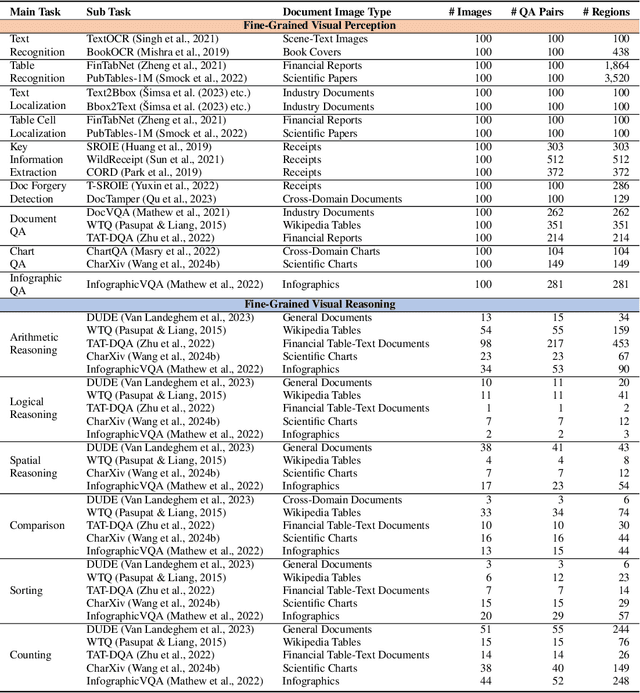

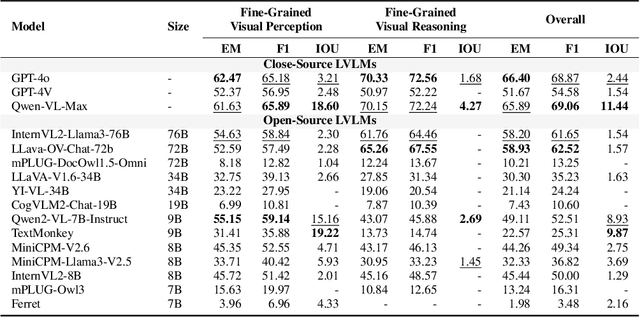
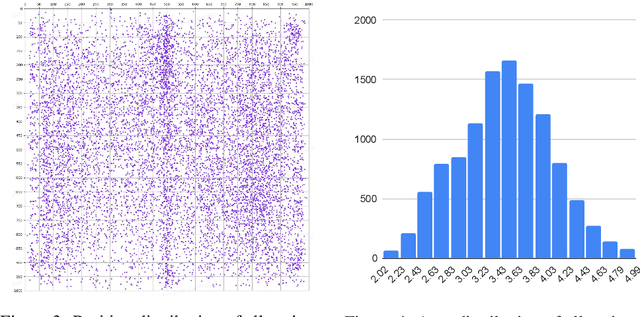
Abstract:Large Vision-Language Models (LVLMs) have achieved remarkable performance in many vision-language tasks, yet their capabilities in fine-grained visual understanding remain insufficiently evaluated. Existing benchmarks either contain limited fine-grained evaluation samples that are mixed with other data, or are confined to object-level assessments in natural images. To holistically assess LVLMs' fine-grained visual understanding capabilities, we propose using document images with multi-granularity and multi-modal information to supplement natural images. In this light, we construct MMDocBench, a benchmark with various OCR-free document understanding tasks for the evaluation of fine-grained visual perception and reasoning abilities. MMDocBench defines 15 main tasks with 4,338 QA pairs and 11,353 supporting regions, covering various document images such as research papers, receipts, financial reports, Wikipedia tables, charts, and infographics. Based on MMDocBench, we conduct extensive experiments using 13 open-source and 3 proprietary advanced LVLMs, assessing their strengths and weaknesses across different tasks and document image types. The benchmark, task instructions, and evaluation code will be made publicly available.
Neumann Series-based Neural Operator for Solving Inverse Medium Problem
Sep 14, 2024



Abstract:The inverse medium problem, inherently ill-posed and nonlinear, presents significant computational challenges. This study introduces a novel approach by integrating a Neumann series structure within a neural network framework to effectively handle multiparameter inputs. Experiments demonstrate that our methodology not only accelerates computations but also significantly enhances generalization performance, even with varying scattering properties and noisy data. The robustness and adaptability of our framework provide crucial insights and methodologies, extending its applicability to a broad spectrum of scattering problems. These advancements mark a significant step forward in the field, offering a scalable solution to traditionally complex inverse problems.
TAT-LLM: A Specialized Language Model for Discrete Reasoning over Tabular and Textual Data
Jan 24, 2024Abstract:In this work, we address question answering (QA) over a hybrid of tabular and textual data that are very common content on the Web (e.g. SEC filings), where discrete reasoning capabilities are often required. Recently, large language models (LLMs) like GPT-4 have demonstrated strong multi-step reasoning capabilities. We then consider harnessing the amazing power of LLMs to solve our task. We abstract a Step-wise Pipeline for tabular and textual QA, which consists of three key steps, including Extractor, Reasoner and Executor, and initially design an instruction to instantiate the pipeline and validate that GPT-4 outperforms all existing methods. However, utilizing an online LLM like GPT-4 holds various challenges in terms of cost, latency, and data security risk, which motivates us to specialize smaller LLMs in this task. We develop a TAT-LLM language model by fine-tuning LLaMA 2 with the training data generated automatically from existing expert-annotated datasets following the Step-wise Pipeline. The experimental results have verified that our TAT-LLM model can outperform all baseline models, including the previous best fine-tuned models and very large-scale LLMs like GPT-4 on FinQA, TAT-QA and TAT-DQA benchmarks. We hope our work can serve as a pioneering example of specializing smaller language models for specific tasks.
Graph Contrastive Learning with Generative Adversarial Network
Aug 01, 2023



Abstract:Graph Neural Networks (GNNs) have demonstrated promising results on exploiting node representations for many downstream tasks through supervised end-to-end training. To deal with the widespread label scarcity issue in real-world applications, Graph Contrastive Learning (GCL) is leveraged to train GNNs with limited or even no labels by maximizing the mutual information between nodes in its augmented views generated from the original graph. However, the distribution of graphs remains unconsidered in view generation, resulting in the ignorance of unseen edges in most existing literature, which is empirically shown to be able to improve GCL's performance in our experiments. To this end, we propose to incorporate graph generative adversarial networks (GANs) to learn the distribution of views for GCL, in order to i) automatically capture the characteristic of graphs for augmentations, and ii) jointly train the graph GAN model and the GCL model. Specifically, we present GACN, a novel Generative Adversarial Contrastive learning Network for graph representation learning. GACN develops a view generator and a view discriminator to generate augmented views automatically in an adversarial style. Then, GACN leverages these views to train a GNN encoder with two carefully designed self-supervised learning losses, including the graph contrastive loss and the Bayesian personalized ranking Loss. Furthermore, we design an optimization framework to train all GACN modules jointly. Extensive experiments on seven real-world datasets show that GACN is able to generate high-quality augmented views for GCL and is superior to twelve state-of-the-art baseline methods. Noticeably, our proposed GACN surprisingly discovers that the generated views in data augmentation finally conform to the well-known preferential attachment rule in online networks.
PANE-GNN: Unifying Positive and Negative Edges in Graph Neural Networks for Recommendation
Jun 08, 2023



Abstract:Recommender systems play a crucial role in addressing the issue of information overload by delivering personalized recommendations to users. In recent years, there has been a growing interest in leveraging graph neural networks (GNNs) for recommender systems, capitalizing on advancements in graph representation learning. These GNN-based models primarily focus on analyzing users' positive feedback while overlooking the valuable insights provided by their negative feedback. In this paper, we propose PANE-GNN, an innovative recommendation model that unifies Positive And Negative Edges in Graph Neural Networks for recommendation. By incorporating user preferences and dispreferences, our approach enhances the capability of recommender systems to offer personalized suggestions. PANE-GNN first partitions the raw rating graph into two distinct bipartite graphs based on positive and negative feedback. Subsequently, we employ two separate embeddings, the interest embedding and the disinterest embedding, to capture users' likes and dislikes, respectively. To facilitate effective information propagation, we design distinct message-passing mechanisms for positive and negative feedback. Furthermore, we introduce a distortion to the negative graph, which exclusively consists of negative feedback edges, for contrastive training. This distortion plays a crucial role in effectively denoising the negative feedback. The experimental results provide compelling evidence that PANE-GNN surpasses the existing state-of-the-art benchmark methods across four real-world datasets. These datasets include three commonly used recommender system datasets and one open-source short video recommendation dataset.
Knowledge Distillation based Contextual Relevance Matching for E-commerce Product Search
Oct 04, 2022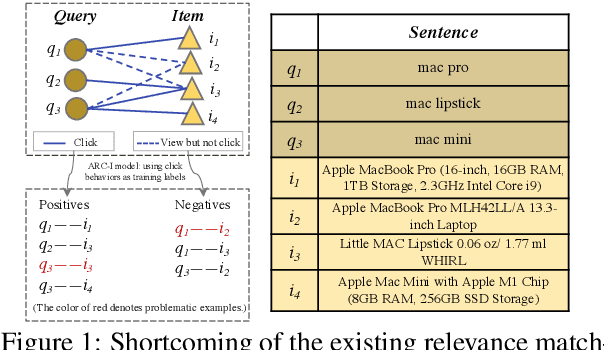
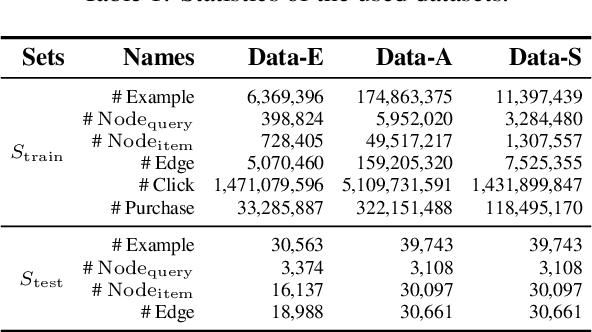

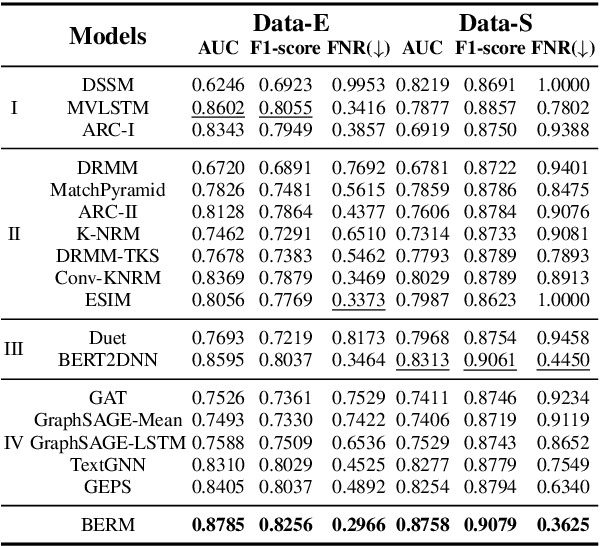
Abstract:Online relevance matching is an essential task of e-commerce product search to boost the utility of search engines and ensure a smooth user experience. Previous work adopts either classical relevance matching models or Transformer-style models to address it. However, they ignore the inherent bipartite graph structures that are ubiquitous in e-commerce product search logs and are too inefficient to deploy online. In this paper, we design an efficient knowledge distillation framework for e-commerce relevance matching to integrate the respective advantages of Transformer-style models and classical relevance matching models. Especially for the core student model of the framework, we propose a novel method using $k$-order relevance modeling. The experimental results on large-scale real-world data (the size is 6$\sim$174 million) show that the proposed method significantly improves the prediction accuracy in terms of human relevance judgment. We deploy our method to the anonymous online search platform. The A/B testing results show that our method significantly improves 5.7% of UV-value under price sort mode.
TeKo: Text-Rich Graph Neural Networks with External Knowledge
Jun 15, 2022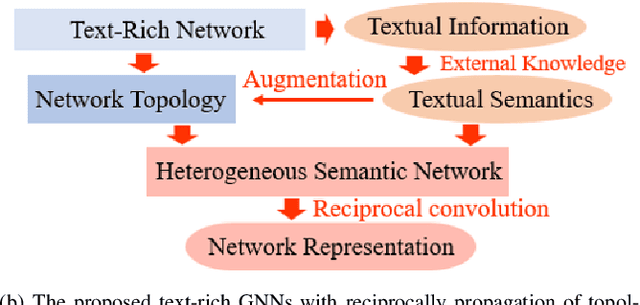
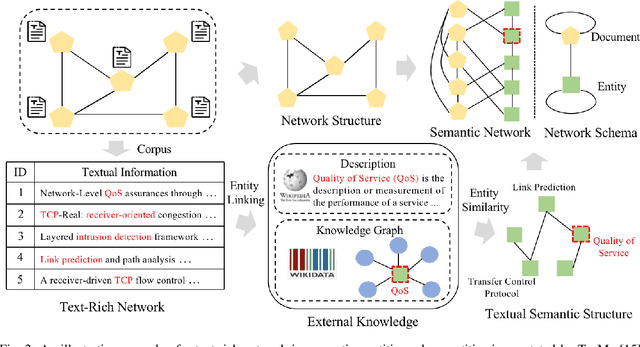
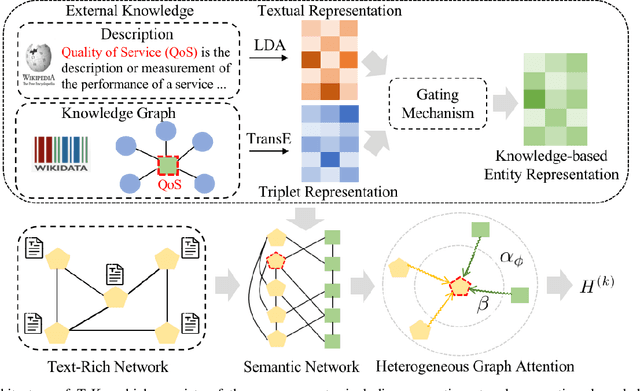

Abstract:Graph Neural Networks (GNNs) have gained great popularity in tackling various analytical tasks on graph-structured data (i.e., networks). Typical GNNs and their variants follow a message-passing manner that obtains network representations by the feature propagation process along network topology, which however ignore the rich textual semantics (e.g., local word-sequence) that exist in many real-world networks. Existing methods for text-rich networks integrate textual semantics by mainly utilizing internal information such as topics or phrases/words, which often suffer from an inability to comprehensively mine the text semantics, limiting the reciprocal guidance between network structure and text semantics. To address these problems, we propose a novel text-rich graph neural network with external knowledge (TeKo), in order to take full advantage of both structural and textual information within text-rich networks. Specifically, we first present a flexible heterogeneous semantic network that incorporates high-quality entities and interactions among documents and entities. We then introduce two types of external knowledge, that is, structured triplets and unstructured entity description, to gain a deeper insight into textual semantics. We further design a reciprocal convolutional mechanism for the constructed heterogeneous semantic network, enabling network structure and textual semantics to collaboratively enhance each other and learn high-level network representations. Extensive experimental results on four public text-rich networks as well as a large-scale e-commerce searching dataset illustrate the superior performance of TeKo over state-of-the-art baselines.
 Add to Chrome
Add to Chrome Add to Firefox
Add to Firefox Add to Edge
Add to Edge